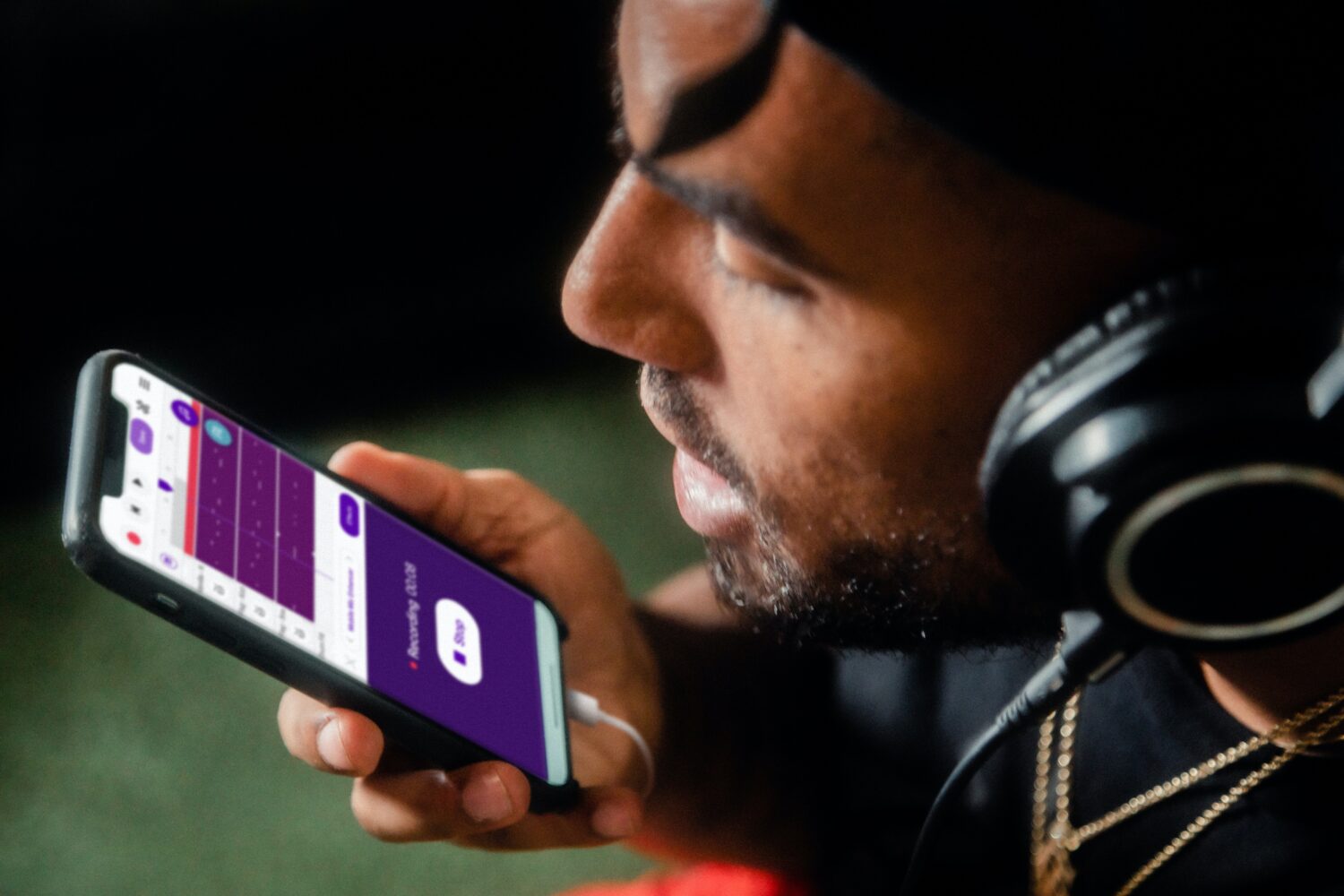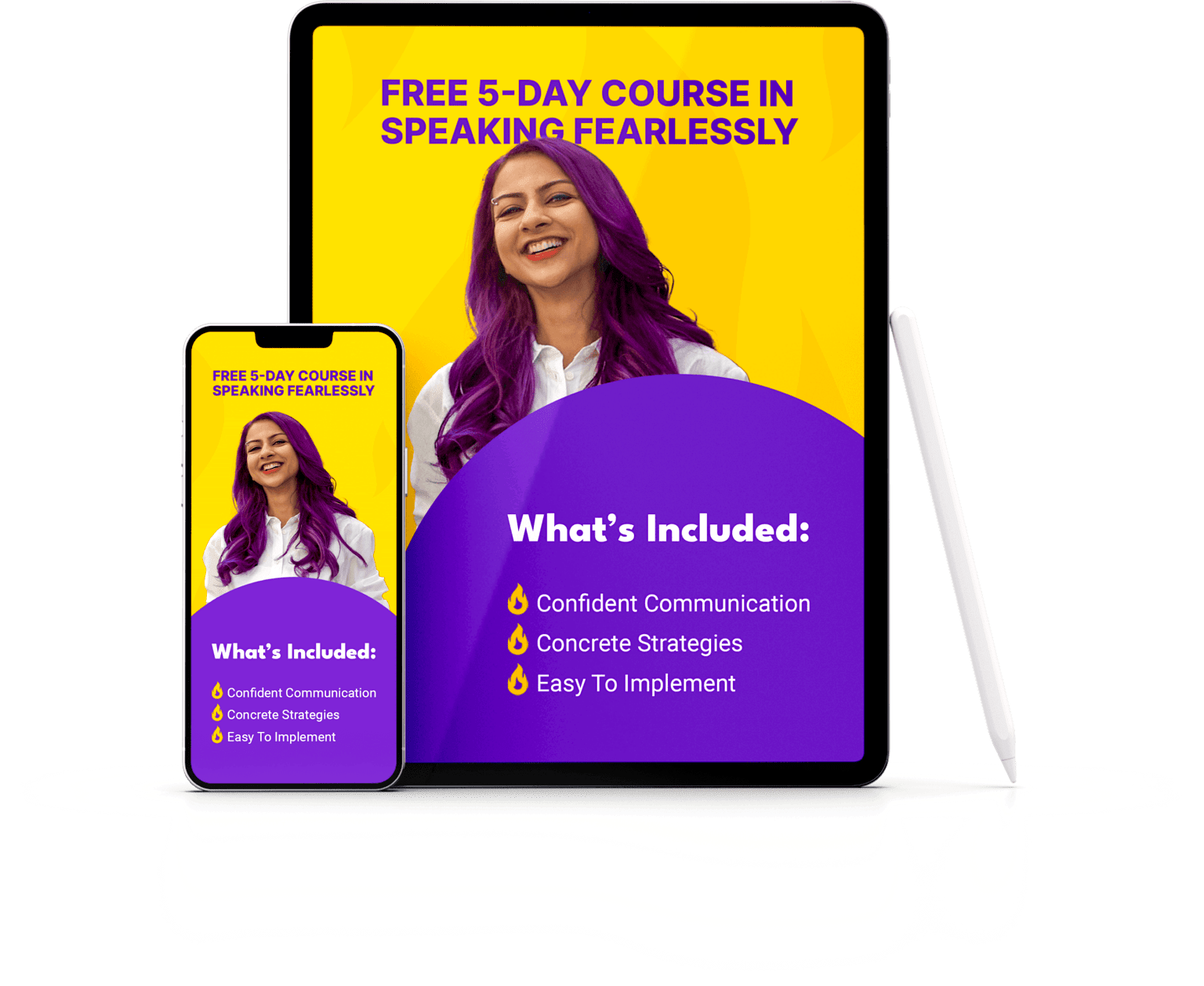When you need to speak on stage, you want to portray your most confident, most articulate self.
But then your nerves catch up with you.
When the spotlight is on you, you feel nervous, your heart beats too fast and you feel out of your depth. What you want more than anything: to feel confident.
Confidence is more than just a feeling; it’s an essential quality that can impact your success on stage.
Here are 9 proven strategies to gain confidence on stage when it matters most: when all eyes are on you and you need to speak with clarity and impact.
Table of Contents
1. What the heck is “confidence” anyway?
When I started working with Sarah, a young CEO, she wanted to be confident before she stepped on stage. She imagined that confidence was like a tool she could own.
But confidence is much more complex as a concept: it’s not like a trophy you get that you can put on your shelf and admire forever. It’s more like a muscle that you build with time. When you first start doing something scary, like speaking in public, your speaking muscles won’t be fully formed at the start. They get formed through intentional practice and good habits. So you may not have a lot of confidence to begin with.

Credit: Photo by Artur Voznenko on Unsplash
The most important thing is to not let your perceived lack of confidence stop you from doing something that scares you. You’re not confident before you do the scary thing. You’re confident because you do the scary thing.
However, there’s a myth that doing a big, scary thing will automatically make you feel confident to do it again next time. The truth is, you gain confidence as a result of creating a positive feedback loop each time you successfully accomplish something scary, like speaking in public.
2. How confident are you already?
Learn to evaluate your speaking skills – when you develop an awareness of exactly how much confidence you portray, you know what you’re doing well and what you can improve.
Do this by recording yourself speaking in an improvised way about a topic that you can easily speak about anytime. A go-to question that you can ask: “What’s the one thing that most people get wrong about your industry?”
I don’t recommend speaking in front of a mirror – this is quite unnatural because you can’t focus on what you’re saying. You’ll be way more self-conscious than you need to be. Read this post to help evaluate your current speaking skills.

Credit: Photo by Harry Cunningham on Unsplash
Now watch yourself back and evaluate your confidence.
Ask yourself: “How confident was I?”
That’s probably a bit difficult to answer right?
Here’s how you can make it a bit more concrete – ask these questions instead:
- How sure of yourself did you seem?
- How clear were you in your response?
- Did you ramble or were you concise?
While it may not be possible to respond to the overarching question of “How confident was I?” it’s easier to think of confidence in terms of specific behaviors that you can show in the moment.
But don’t just stop there…

3. Inner vs outer confidence
Confidence is more than a specific set of behaviors.
It’s the belief in one’s abilities and judgments. In the context of public speaking, it’s about trusting yourself to convey your message effectively and engagingly. It’s the mental and emotional foundation that empowers you to stand tall, even when faced with a sea of eyes.
It’s not too difficult to “learn” how to show confidence but if you’re not confident on the inside, you may feel like you’re putting on a show.
Psychologist Carol Dweck’s concept of a growth mindset is applicable here. Cultivate both inner and outer confidence. While outer confidence is evident in your mannerisms, inner confidence comes from embracing challenges and valuing the learning process.
4. Confidence for shy introverts
For shy introverts, the prospect of public speaking can be particularly intimidating. However, it’s important to recognize that introversion isn’t a barrier to confidence; it’s a unique trait that can be harnessed to your advantage. Susan Cain, author of “Quiet: The Power of Introverts in a World That Can’t Stop Talking,” emphasizes that introverts bring valuable qualities to the stage, such as deep thinking and empathetic communication.

Photo by Upesh Manoush on Unsplash
Start by acknowledging your introversion as a strength rather than a limitation. Leverage your natural inclination to prepare thoroughly. Rehearse your content until you feel a strong sense of familiarity, giving you the confidence to navigate unexpected twists during your presentation.
Additionally, focus on connecting with your audience on a personal level. Introverts often excel at listening and understanding, which can help you tailor your message to resonate deeply. Set aside time before your talk or presentation to engage in a conversation with attendees; this will create a sense of familiarity that eases your nerves.
Remember, confidence for shy introverts is about embracing your unique qualities and finding comfort in your authenticity. The stage (or being on camera) is your platform to share insights and inspire, and your introverted nature can be a powerful tool in leaving a lasting impact.
5. Portray confident body language
Your body language speaks volumes about your confidence – both on stage and on camera.
When you’re on stage, you can do a few things to show confidence through your body language:
- Stand with your legs slightly apart.
- Stand still with your feet grounded – don’t sway or shift your weight from one leg to another.
- Use your upper body to animate yourself- use a variety of hand gestures that add emphasis to your content.
- Avoid keeping your hands in your pockets or moving them erratically.
- Once you’ve mastered standing still, you can move around the stage with intention.

Photo by Will Kell on Unsplash
On camera, you can use the same technique – whether you’re standing or sitting.
When you’re sitting and presenting, keep grounded. Don’t swing your chair. Keep your lower half as still as possible and make sure you’re intentionally using and showing your hands in the frame as you use gestures.
6. Portray confidence through your voice:
Your voice is a powerful instrument that can convey not only the words you speak but also a range of emotions and intentions. To project confidence through your voice, consider the following techniques:
- Speak Slowly and Clearly: Clear articulation signals confidence. Speaking slowly not only ensures your audience comprehends your message but also adds an air of self-assuredness to your speech.
- Utilize Pauses: Pauses can emphasize key points, allow your audience to digest information, and give you a moment to breathe and collect your thoughts.
- Control Your Pitch: Create an awareness of what pitch you’re using. Make an effort to utilize different pitches to achieve different kinds of impact: higher pitches convey excitement while lowering your pitch adds gravitas.
- Infuse Variety: We’re monotonous in our everyday conversations. Vary your tone, volume, and pace to maintain audience engagement. A monotonous voice can dull the impact of your words.
- Projection: Speak from your diaphragm, not your throat. Practice diaphragmatic breathing so that you can make a bigger impact with your voice when you speak.

Photo by Soundtrap on Unsplash
7. Confident energy on stage
Confident energy isn’t just about appearing self-assured; it’s about embodying enthusiasm, authenticity, and a magnetic presence that captivates your audience.
But a lot of people simply forget (or neglect) to turn themselves “on” when they speak.
Here are 3 things you can do to boost your energy when you’re in the spotlight:
- Embrace Nervous Energy: Embrace your nervous energy by reframing it as excitement. Transform jitters into enthusiasm, and your energy will appear authentic and infectious.
- Passion Fuels Confidence: You’re most likely speaking about subjects you’re very passionate about. Tap into that enthusiasm and make sure it shines through your words.
- Warmup and pre-game: Get into the zone before you need to speak or present. Create a warmup routine that gets you physically, mentally and vocally warmed up. Some people like listening to a favorite song and dance to it. Others like meditating or listening to a favorite podcast.
8. How to combat the imposter syndrome when you speak
Even the most accomplished speakers and leaders feel the imposter syndrome. I’ve talked to senior-level directors who question whether or not they deserve to be speaking to a wide audience.
Here are 3 ways you can combat the imposter syndrome when you need to speak to a large group:
- Acknowledge Your Achievements: Reflect on your past speaking successes. Remind yourself of the hurdles you’ve overcome and the knowledge you bring. You’re there to share your experience and expertise – no one can challenge that.
- Internalize Audience Connection: Shift your focus from self-doubt to serving your audience. When you prioritize delivering value and meeting your audience’s needs, you shift the spotlight away from your perceived inadequacies.
- Practice and Preparation: The more prepared you are, the less room imposter syndrome has to take hold. Assign time specifically to practice your talk or presentation – remember that practice boosts your confidence and helps silence that inner critic.

Photo by Debby Ledet on Unsplash
9. How to practice confidence
You can practice your talk – but how do you practice confidence?
The trick is to approach everyday situations with confidence so that you get into the habit of speaking with confidence, regardless of whether you’re on a stage or not.
Speak with clarity, enunciate, be concise and emulate effective body language. You might surprise your friends or your spouse- but once you get into the habit of constantly exuding confidence, you’ll start feeling like confidence is a friend who never leaves your side.
Use these 3 techniques to practice confidence daily:
- Progressive Exposure: Once you’re practicing confidence in everyday conversations, venture out of your comfort zone. Start with smaller speaking engagements to build your confidence progressively. As you experience success in manageable steps, your self-assurance will naturally grow.
- Visualization and Mental Rehearsal: Before stepping on stage, spend time vividly imagining yourself speaking with authority and poise. This mental rehearsal enhances your sense of preparedness and primes your mind for success.
- Constructive Self-Talk: Monitor your self-talk closely. Challenge and reframe negative thoughts about your speaking abilities. Replace them with affirming statements that reinforce your confidence.
Learn to use feedback to fuel your confidence: seek feedback after each speaking engagement and debrief with yourself too. Constructive criticism provides insights into areas for improvement, while praise acknowledges your strengths.
You can absolutely achieve high levels of confidence when you speak in public through consistent effort and self-awareness. By understanding the nuances of body language, voice modulation, and mindset, you can transform your speaking skills. Remember, confidence is not about perfection; it’s about connecting with your audience and delivering your message with authenticity and impact.
If you’re looking for more personalized help, check out how to work with me 1:1.
And if you enjoyed this article, you may also like “How to Overcome Stage Fright”.



